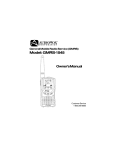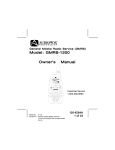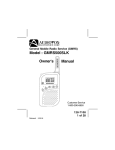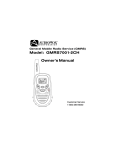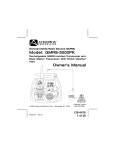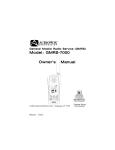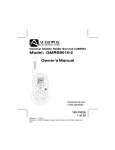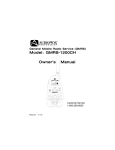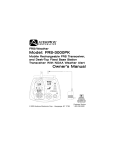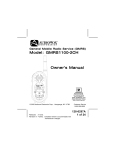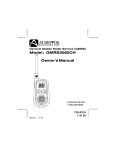Download Model: GMRS2VMK Owner`s Man `s Man `s Manual
Transcript
Gener al Mobile Radio Ser vice (GMRS) General Service Model: GMRS2VMK Owner ’s Owner’s Man ual Manual EMG EMG HI ID LO CTC CTC ID FAST INTELLIGENT CHARGER OUT OF OUT OF RANGE RANGE MODE SCAN EMG Customer Service 1-800-290-6650 CAUTIONS Never attempt to charge alkaline or dry cell batteries, as batteries may burst causing personal injury and damage to the product. When recharging nickel metal hydride (NiMH) batteries with the Audiovox charger, use only Audiovox approved rechargeable batteries. The Audiovox rechargeable batteries were designed to provide optimum operation for your radio in various environmental conditions. Use of the Audiovox charger with other brands of batteries is not recommended, as battery charging times will vary with different brands. Refer to the manufacturer’s instructions for charging other brands of batteries. Avoid placing the GMRS2VMK radio transceiver for prolonged periods of time in direct sunlight or temperatures below 4° F (-20° C) or above 140 ° F (60° C). Keep the antenna at 1 inch (2.5 cm) away from your head and body. Do not use your GMRS2VMK radio transceiver with a damaged antenna. Place the rubber cover on jacks when not in use. Check the laws and regulations on the use of radio products in the area where you drive. Always obey them. When using the radio product while driving, please: • Give full attention to driving and to the road. • Pull off the road and park before transmitting or receiving a call if driving conditions so require. GMRS license: Use of this radio within the United States requires an FCC GMRS license. An individual 18 years of age or older, who is not a representative of a foreign government, is eligible to apply for a GMRS system license. You will need two forms from the FCC; FCC Form 159 and FCC Form 605 Main Form and Schedule F. You can find the forms online at: http://www.fcc.gov/formpage.html, or call 1-800-418-3676. 2 FEATURES Your GMRS2VMK Radio is a portable, easy to use, two-way radio that you can carry almost anywhere. The Fast Intelligent Charger can be mounted in a vehicle and is designed for a vehicle environment. The GMRS2VMK is skillfully constructed to give you reliable communications for many different applications. The GMRS2VMK is ideal for use around the house, in your boat, on hunting and camping trips, on the ski slopes or at the mall. The GMRS2VMK is comprised of the items below: PERFORMANCE Your transceiver will achieve its maximum operating range when communicating with other transceivers in a flat open area with no trees or buildings obstructing its signal. Range may be up to five miles under such conditions. Obstacles such as buildings, trees or mountains will tend to reduce the transceiver’s effective range. The transceiver is designed to operate using the Audiovox supplied four AAA rechargeable NiMH batteries. M O DE SCAN CAN EM G Radio Part Number GMRS-1200 Rechargeable Batteries Part Number HR4U Fast Intelligent Charger Part Number 2VMKCHG 3 Cigarette Lighter Adapter Cable Part Number 2VMKCIG GMRS2VMK (FCC License Required) 5 6 4 16 8 3 13 12 EMG EMG CTC HI CTC 14 ID LO ID OUT OF RANGE OUT OF RANGE 2 3 (REF) MODE SCAN EMG 15 1 10 9 7 11 1 (REF) 10. Up Channel/Volume Button 11. Down Channel/Volume Button 12. MODE Button 13. SCAN/Lock Button 14. Emergency (EMG) Call Button 15. Power On/Off Control 16. Combination Transmit Indicator (Red)/Receive and Monitor Indicator (Green) 1. Battery Door 2. Monitor/Backlight Button 3. Detachable Carry Clip Part Number 2VMKBLT 4. Push-To-Talk (PTT) Button 5. Antenna 6. External Speaker(SPK)/Microphone (MIC) Jacks 7. Built-in Speaker 8. Liquid Crystal Display (LCD) 9. Built-in Microphone 4 GMRS2VMK DISPLAY 8 1 2 EMG 3 HI CTC 9 LO ID 4 5 OUT OF RANGE 6 10 11 12 13 14 15 7 16 1. Beep Tone Indicator: Icon appears when beep button confirmation tone is selected; icon disappears when tone is off. 2. Monitor Indicator: Icon appears when the Monitor (M) button is pressed and the channel monitor function is activated. 3. Key Lock Indicator: Icon appears when the keypad is locked. This function disables keys such as channel up/down and MODE. 4. Signal Strength Indicator: Icon appears when a signal is being received. The icon consists of five bars to indicate the received signal level. 5. Coded Tone Controlled Squelch System (CTC) Indicator: Indicator appears when the CTCSS tone function is active. 6. Large Segment Display: Indicates the channel number in use. 7. Scan Indicator: This function allows the user to scan a channel and/ or a tone code every .5 second to search for a valid signal. 8. RogerBeep Tone On/Off Indicator: This icon appears when the Roger Beep tone is on, and disappears when tone is not in use. 9. Battery Level Indicator: Icon indicates the battery charge level. 10.Emergency Indicator: EMG Icon appears when the EMG button is pressed. (The frequency is NOT monitored by authorities). 11. HI/LO Indicators: Appropriate indicator appears when the transmit power is set to desired output power on the GMRS channels. 5 12.Caller Identification (ID) Indicator: This indication appears when you select a caller identification code (between 1 and 10). ID selection operates in conjunction with the small segment display, and can also be used to identify a calling party in the monitor mode. 13.Small Segment Display: Displays the CTCSS tone option in the channel from (00-38). 14.Out of Range Indicator: Icon will be on steady when received signal strength is normal; icon flashes when signal strength becomes weak and intermittant. 15.Voice Activated Transmission (VOX) Indicator: This function allows hands free conversation. The indicator appears when the VOX mode i s activated. 16.Dual Watch Mode Indicator: Indicator appears when dual watch mode i s active. Powering the transceiver: Your GMRS2VMK radio transceiver operates on four AAA batteries. Only Audiovox approved rechargeable batteries should be recharged in the radio transceiver using the Fast Intellegent Charger. This will ensure optimum performance for the GMRS2VMK. Use of the Fast Intellegent Charger with other brands of batteries is not recommended as battery charging times will vary. Refer to the manufacturer’s instructions for charging other brands of batteries. Batteries There are three methods of powering the GMRS2VMK: 1. Alkaline Batteries. WARNING: Do not attempt to recharge Alkaline batteries. 2. Audiovox Rechargeable NiMH Batteries -It is strongly recommended that only Audiovox approved rechargeable batteries and the Fast Intelligent Charger be used while charging batteries internal to the transceiver. NOTE: To extend battery life, avoid overcharging the batteries. 6 3. Various Brands of Rechargeable Batteries - Use of the supplied Audiovox charger with other brands of rechargeable batteries is not recommended, as battery charging times will vary with different brands of batteries. Refer to the manufacturer’s instructions for charging other brands of batteries. Installing the batteries: Battery installation is made more convenient when the carry clip is removed. To do this, release the spring latch securing the clip to radio and slide the clip downward and away from the radio body. Next, press down with the thumb at the embossed arrow, slide the battery cover down and lift off the battery cover. Insert four AAA batteries (alternate positive ends (+) toward the bottom of the transceiver, (starting left-to-right). SPRING LATCH COVER ARROW CARRY CLIP PART NUMBER 2VMKBLT + POSITIVE TERMINALS + BATTERY COVER 1. Using thumb, press down on battery cover at arrow and slide cover down to open. + 2. Slide the cover down and then lift cover at bottom to open.Remove cover. 7 + 3. Insert four AAA batteries (positive (+) end toward the bottom begining at left side and alternating positive terminals as shown). Mounting the Charger The Fast Intelligent Charger can be mounted horizontally or vertically in a vehicle. Mount the Fast Intelligent Charger using the following procedure: 1. Hold the charger up to the surface where is to be mounted. 2. Using a marker, mark the location of where the mounting holes are going to made. WARNING! Never install above your fuel tank as the holes you must drill may pierce the tank or the fuel lines. Also check for other obstructions such as wires, etc. 3. 4. Drill the mounting holes and using the screws provided, mount the charger in the desired location. Cover the screw heads of the mounting screws with the covers provided. VERTICAL MOUNTING HORIZONTAL MOUNTING MOUNTING SCREW HOLES MOUNTING SCREW COVERS MOUNTING SCREW HOLES 8 Where to Install the Charger The Fast Intelligent Charger can be mounted horizontally or vertically in any suitable location within the trunk, passenger compartment or rear cargo area of your vehicle. When mounting the charger in the trunk it maybe necessary route the cigarette lighter adapter wiring from the trunk to your car dashboard if no closer power outlet is available. The cigarette lighter adapter cable is approximately 16 feet long. WARNING! Never install above your fuel tank as the holes you must drill may pierce the tank or the fuel lines. Also check for other obstructions such as wires, etc. MOUNT ON SIDE WALL MOUNT UNDER LIP OF TRUNK 9 Using the Fast Intelligent Charger The Fast Intelligent Charger will typically fully charge the transceivers in two hours. LEDs mounted on the front of the charger provide visual status of the charging process. Charging Indicators Status Steady Yellow: The charging process is not taking place. Charging will not occur at temperatures below 14 degrees Fahrenheit (-10 degrees Celsius) or above 140 degrees Fahrenheit (60 degrees Celsius). Blinking Red: The charging process is not taking place. The batteries need to be replaced. Steady Red: Charging in progress. NOTE: Observe the charging LED indicators after one minute to ensure that charging is taking place. If charging LEDs are blinking, replace the batteries. Steady Green: Batteries are fully charged. CHARGING LED INDICATORS 10 Powering the Charger with the Cigarette Lighter Adapter The GMRS2VMK Fast Intelligent Charger obtains its operating power using the Cigarette Lighter Adapter. Use the following procedure to connect the charger to input power: 1. Insert the GMRS2VMK Cigarette Lighter Adapter connector into the charger base by aligning it with the pins on the connector on the back of the charger base. 2. Press down on the connector locking tab and press the connector into place. The connector will lock in place. 3. Connect the GMRS2VMK Cigarette Lighter Adapter connector to a standard +12 Volt DC power outlet. 4. To release the connector, lift the locking tab and remove the connector form the charger base. NOTE The GMRS2VMK Cigarette Lighter Adapter is equipped with a 2-Amp fuse mounted beneath the removable cover assembly. Fast Intelligent Charger Rear View Power LED Indicator Connect to a +12VDC Source Fuse Cover Cigarette Lighter Adapter Cable Charger Base 2-Pin Locking Tab 11 Mounting the Transceiver in the Charger The transceiver is designed to lock into the Fast Intelligent Charger. Use the following procedure: 1. While holding the transceiver in the palm of your hand, reach the carry clip handle and press down to open the carry clip. 2. While the carry clip is in the open position, move the transceiver downward into the charger base. 3. Press the transceiver firmly into the base. 4. Release the carry clip handle and ensure that the transceiver is secure by lightly pulling up on the unit. The unit should be locked to the charger base and the charging indicator should be red. Carry Clip Spring Latch Carry Clip Handle Carry Clip Part Number 2VMKBLT Carry Clip Locking Tab GMRS2VMKCHG Fast Intelligent Charger Side View 12 GMRS2VMK OPERATIONAL MODES MODE CHANNEL SELECT CTCSS SELECT POWER SELECT (GMRS Channels Only) VOX SELECT DUAL WATCH ROGER BEEP BUTTON BEEP ID SELECT Controls: CALL SELECT Power On/Off (15) Button Press and hold the power on/off button ( ) for at least 2 seconds. You will hear a confirming melody to indicate the unit is on. To turn the unit off, press and hold the button for at least 2 seconds. Adjusting the Volume With the unit powered on, press the Up Channel/Volume button ( ) to increase volume and the Down Channel/Volume button ( ) to decrease volume. The display will indicate the current volume level between 1 and 7 by the small number in the icon ( U 05 ). 13 Monitor/Display Backlight Button (2) This button is used to check activity on the current frequency before transmitting. Check activity by pressing the Monitor (M) Button longer than 2 seconds; the icon will apppear on the display and you will hear static if frequency is clear. Do not transmit if you hear conversation. Hold down the Monitor Button again longer than 2 seconds and the icon will disapppear from the display. The monitor function will temporarily bypass the squelch setting and play all signals on a given channel. This feature is useful when communicating with other parties at extreme range. By pressing the monitor button momentarily, the LCD backlight is turned on accompanied by a beep tone; the LCD backlight will turn off automatically in about 5 seconds, or when the monitor button is pressed momentarily once again. Push To Talk (PTT) Button (4) Pressing and holding this button will allow you to speak to any transceiver that is set to the same channel and privacy code setting as yours. Hold the transceiver approximately 1 to 2 inches from your face as you speak into the built in microphone (9). After you have finished speaking, release the PTT Button to allow reception of incoming signals. It is not possible to transmit and receive at the same time. The Transmit/Monitor LED (16) at the upper inside right corner of the LCD Panel (8) will light red while the PTT Button is pressed. Releasing the button allows the unit to revert to standby mode. When receiving an incoming signal, the Transmit/Monitor LED indicator will light green and the received signal strength indicator ( ) will display the relative strength of the signal. The PTT Button can also be used as a two-way call ringer. Pressing the button twice quickly will call another party on the same channel. The Transmit LED will light red for approximately 3 seconds and then go out. 14 Up Channel/Volume Button (10) In the standby mode, pressing this button will increment the listening volume. When in function edit mode this button will be used to adjust the unit’s settings. Down Channel/Volume Button (11) In the standby mode, pressing this button will decrement the listening volume. When in function edit mode this button will be used to adjust the unit’s settings. Mode Button (12) This button is used to select the various GMRS feature settings such as channel/CTCSS code selection, VOX mode, etc. Emergency (EMG) Call Button Button (14) This radio has a quick access button (EMG) to the Emergency and Assistance Channel. This channel is not monitored by local authorities. When using this channel, EMG appears on the display. Pressing this button will set the transceiver to channel 20, operating on 462.6750 MHz. External Speaker (SPK)/Microphone (MIC)/(CHG) Jack (6) This jack accepts an Audiovox headset/microphone connector, or the Charging Adapter connector. The Charging Adapter is supplied with the unit. For additional optional equipment and accessories for the GMRS2VMK visit the Audiovox web site at www.audiovox.com. Scan/Lock Button (13) Press this Button momentarily to enable or disable the scan mode. Press and hold Button for more than 1 second to lock or unlock the key pad, except Power, PTT and Monitor (M) and Volume Up/Down. When the keypad is locked, the ( ) icon will display in the top left corner. 15 Operating Modes and Features GMRS Operation: - From GMRS standby mode, press and hold the ( ) button for 2 seconds to turn on power. - Press the MODE button so the Channel number flashes. - Select the desired channel with the Up (10) and Down (11) Buttons. When receiving a call, the signal strength meter appears to indicate incoming received signal strength and the Monitor section of the Transmit/Monitor LED (16) lights green. - Press and hold the PTT button (4) to transmit, then speak into the microphone clearly and slowly. The Transmit section of the Transmit/Monitor LED (16) lights red. - Release PTT Button (4) to receive. - Communication can only be accomplished when the channel and CTCSS tone frequency of at least two parties are the same. - The CTC icon will be displayed on the LCD panel if the CTCSS tone frequency function is enabled. Channel Selection In order to communicate with other GMRS units, both transmitting and receiving party must be on the same frequency. The GMRS2VMK has 22 channels (frequencies) indicated by the large digits on the LCD display panel. Channels 1 through 7 are the shared GMRS/FRS channels. Channels 8-14 are FRS only channels, while channels 15-22 are assigned GMRS only channels. If an FRS only channel (8-14) has been selected, the HI or LO indicator will not be displayed on the LCD panel; otherwise, for channels 1-7 (GMRS/FRS) and 15-22 (GMRS only), the HI or LO indicator will be displayed. Communication with Audiovox FRS and compatible units is possible on these seven channels. Before transmitting on the selected channel, press the Monitor (M) Button (2) to check the activity on that channel. If there is activity on the selected channel, change to another channel that is clear. 16 To change the channel: - From GMRS/FRS standby mode, press the MODE button (12) once, or until the channel number flashes. - Press the Up Button (10) briefly to move to the next higher main channel number. - Press the Down Button (11) briefly to move to the next lower main channel number. - Press the PTT button momentarily to confirm selection. CTCSS Mode (Sub-Channel) Selection The Coded Tone Controlled Squelch System (CTCSS) provides 38 Sub-Frequencies. This feature allows you to utilize the coded squelch tones (01–38) within a main channel. This enables you to communicate with another party on the same main channel using the same subcode. (This filters out unwanted transmissions without the same coded squelch tone). There are 38 CTCSS Sub-channels for each main channel. A different subcode may be selected for each of the 22 channels. To change the CTCSS Sub-channel: - From GMRS/FRS standby mode, press the MODE Button twice; a flashing oF or sub-channel number is displayed, together with the flashing CTC icon. If oF is displayed, press the Up or Down button to enable the CTCSS mode; the CTC icon will also flash on the display with the flashing sub-channel number. - Then press the Up or Down button to select the desired sub-channel for use (01-38). - Press the PTT button momentarily to confirm selection. The CTCSS mode can be turned off by selecting the oF icon as the setting. NOTE: To communicate with other GMRS/FRS units, they must be switched to the same channel and CTCSS subcode. To communicate with other GMRS/FRS units that do not have subcodes, switch your unit to the same channel with the subcode set to oF. The CTCSS subcodes do not prevent others from hearing your transmission. This will only allow you to ignore all traffic on a given channel not using the same subcode. 17 Transmit Power Selection Mode This feature permits selection of the transmitting power level to high or low. (FRS channels 1-7 operate on low power.) Using low power, the unit will have a lower transmit range, but battery life will be increased. NOTE: You will find that for the majority of your needs, the low-power setting will provide adequate communications on all channels; there should seldom be any need to use high power, except in situations where you need absolute maximum range. Using low power will greatly extend battery life. We suggest you experiment with switching between low and high power. However, we do recommend that you not change this setting unless it proves to be necessary in your particular situation. To access the transmitter power selection function: - From GMRS/FRS standby mode, press the MODE Button three times until the Po HI or Lo indication appears with a flashing HI or LO indication on the display. - Press the Up or Down button to toggle between the High and Low selections. - Press the PTT button momentarily to confirm selection. VOX Selection Mode This option enables you to have hands-free conversation. Your voice or nearby sound is detected and the radio transmits without the need to press the PTT button. To set radio for VOX operation: - From GMRS/FRS standby mode, press the MODE button 4 times until the VOX icon flashes on the display. - Press the Up or Down button to select VOX On (if oF appears flashing) and the 1-5 VOX level sensitivity. - Press the PTT button momentarily to confirm the VOX selection. - The VOX icon will appear steady on the LCD display. VOX can be turned off by selecting oF as the setting. 18 Dual Watch Mode This feature allows you to monitor two channels at the same time. While in dual watch mode, the unit will continuously monitor both the primary and dual watch channel. Received signals will be played for 5 seconds, then the unit will resume scanning the two channels. Pressing the PTT button during a received transmission will set the unit to transmit on the same channel. Pressing the PTT button when no signal is received will set the unit to transmit on the primary channel. To set the Dual Watch Mode: - From GMRS/FRS standby mode, press the MODE button 5 times; dc appears on the display with the flashing DW icon. If the dual watch mode is off, the oF icon will also appear flashing. - To enable the dual watch mode, press the Up or Down button; the dual watch channel number will flash and start to increment up or down as the Up or Down button is pressed. - Press the PTT button momentarily to confirm selection of the dual watch channel. The display will now alternate between the primary channel and the dual watch channel just selected. Roger Beep Tone The Roger Beep is a tone which is automatically transmitted whenever the PTT button is released. This tone alerts the receiving party that the transmission has been terminated intentionally. To enable and disable the Roger Beep tone: - From GMRS standby mode, press the MODE Button 6 times until rb appears on the display with the flashing Roger Beep icon ( ) and On or oF. - Press the Up or Down Button to select the tone on or off as desired. - When enabled, the tone icon ( ) appears steady on the display. - Press the PTT button momentarily to confirm selection. 19 Key Tone This feature allows the transceiver to sound a confirmation tone whenever the following keys are pressed: Monitor (M) Button, Up/Down Buttons, MODE Button, SCAN Button, or the EMG Button. To turn the key tones on or off: - From GMRS/FRS standby mode, press the MODE Button 7 times until bP, the Bell ( ) icon, and On or oF flash on the LCD display. - Press the Up or Down Button to toggle the key tone feature On or Off. - Press the PTT button momentarily to confirm selection. When the key tone feature is on, the Bell icon appears steady on the display, and the beep tones sound in response to button activation. Caller Identification (ID) Select The caller ID function allows you to assign an ID code between 1 and 10; this code accompanies your transmission whenever you call another party, and will appear at the receiving unit, provided it has caller ID capability. To select a caller ID code for your unit: - From GMRS/FRS standby mode, press the MODE button 8 times; Id appears, together with a flashing ID and number (or oF) indication. - If oF appears, press the Up or Down Button to select the desired caller identification code for your unit between 1 and 10. - Press the PTT button momentarily to confirm selection. Now, your caller ID number will accompany each transmission, and will appear on the receiving unit, if so equipped, and vice-versa. Call Ringer Selection Mode The transceiver provides 3 user-selectable call ringer melodies to alert you to an incoming call. To select your favorite call ringer melody: - From GMRS/FRS standby mode, press the MODE button 9 times; C will appear on the display, together with a flashing number (or oF) between 01 and 03, and an appropriate call ring. 20 - Press the Up or Down Button to preview and hear the 3 available call melodies. - Press the PTT button momentarily to confirm selection. Refer to the PTT button (4) to transmit ring signal. Channel Scan Operation This feature allows you to monitor all channels automatically for valid signals. While scanning, you can transmit and receive. When a signal is received, the scan is interrupted and will return to scan mode 5 seconds after reception is terminated. NOTE: While the scan function is active, the MODE button will be inoperative. The scan mode will reduce the overall battery life since the battery save function is overridden. To enable the channel scan mode: - From GMRS/FRS standby mode, momentarily press the SCAN But ton; (SCAN) will appear on the LCD display. - The radio will display each channel (1-22) in order as the scan mode operates to find an active main channel. - If the unit doesn’t find any signals and you want to transmit, press the PTT switch to return to home channel operation. The transceiver will automatically resume scanning approximately 5 seconds after the communication is completed. - If there is no activity and you want to leave the scan mode, press the SCAN button momentarily and the unit will return to normal operation; (SCAN) icon will disappear from the LCD display. Auto Key Lock Selection Mode This feature prevents accidental channel change to the preferred settings of the unit. The Auto Key Lock function temporarily disables the MODE and SCAN Buttons. To access the Auto Key Lock selection menu: - From GMRS/FRS standby mode, press and hold the Scan Button for over 2 seconds to Lock the Auto Key function; the ( ) icon appears on the display. 21 - The Power, PTT, Up/Down, EMG and Monitor Buttons are not effected. - To unlock the Auto Key function, press and hold the SCAN button for at least 2 seconds; the icon ( ) disappears from the display. NOTE: If the unit is turned off while Key Lock is on, the Key Lock mode will still be in effect when the unit is turned on again. Emergency and Assistance Channel Mode This radio has a quick access button (EMG) to the Emergency and Assistance Channel. This channel is not monitored by local authorities. When using this channel, EMG appears on the display. Pressing this button will set the transceiver to the channel 20, 462.6750 MHz). The Emergency Channel can be used transmit and receive on a special frequency (CH20: 462.6750 MHz). The Emergency Channel can be selected quickly from any user mode. To access the Emergency Channel mode: - Press Emergency (EMG) Button; EMG and Channel 20 appears on the display. - To turn off the Emergency Channel feature, press and release the EMG Button. Out of Range Indication The GMRS2VMK provides an Out-of-Range indication when reception is no longer intelligible or too weak to be discernible. When this condition icon appears on the display, occurs, the OUT OF RANGE message and reminding you that you are outside the 5-mile range of the unit, or that signal reception is being obstructed by native or man-made objects. Battery Alert When the battery icon ( ) blinks on the LCD panel, recharge unit or install fresh batteries. If the batteries are not replaced the ( ) icon will appear and an audio tone will sound to warn the user that the batteries must be replaced. 22 NOTES FOR GOOD COMMUNICATION 1 . The GMRS2VMK 22 channels are shared on a ‘take turns’ basis. This means other groups may be talking on any of the channels. A common code of ethics/courtesy is to switch to another vacant channel and not to attempt to talk over someone who is already using the channel you first selected. 2. The GMRS2VMK has been designed to maximize performance and improve transmission range in the field. To avoid interference, it is recommended that you do not use the units closer than 5 feet apart. 3. For best transmission results, always keep your mouth about 2-3 inches from the microphone (9) and speak slowly in a normal voice. 4. To increase battery life, avoid features such as Scan and Dual Watch. These features will reduce operating time considerably. Warning • Do not operate the transceiver unless you are licensed to do so. • Remove the batteries from the transceiver if it is not expected to be used for long periods. This will eliminate the possibility of chemicals leaking from the batteries and corroding the transceiver. • Avoid exposing the transceiver to water or extremes of temperature. • Do not use this device in or near a mining facility, which uses remotely triggered explosives or in areas labeled “Blasting Area”. Premature or accidental detonation may result. • Do not attempt to modify or in any way increase the output of this transceiver. Its output is designed to meet the legal limits set by the FCC. • Do not use this device or change its batteries in potentially explosive atmospheres as sparks in such areas could result in an explosion. • Turn your transceiver off wherever posted notices restrict the use of radios or cellular telephones. Facilities such as hospitals may use equipment that is sensitive to RF energy. 23 •Do not place your radio in front of a vehicle’s air-bag. If the air-bag deploys, it could propel the transceiver like a projectile causing bodily injury. Troubleshooting Problem Possible cause No transmission while pressing the PTT Button Weak batteries Incorrect battery polarity Weak or no signal received Weak batteries Channel and privacy code not set the same as target transceiver Volume level too low PTT Button inadvertently depressed Excessive radio interference on a particular channel Obstruction of radio signal Unit beeps, but will not function when turned on Reception of unwanted signals Transceiver does not charge Batteries extremely discharged CTCSS privacy mode not on Interference from electronic devices such as computers or TVs Cigarette Ligther Adapter 24 Correction Charge or replace batteries Install the batteries following the directions in paragraph Installing the Batteries. Charge or replace batteries Adjust the transceiver’s settings to match those settings of the target transceiver. Increase volume level Release PTT Button Change to a different channel. Avoid operating in or near large buildings or vehicles. Charge or replace batteries Turn on the CTCSS privacy mode and set code number to match the setting of the target transceiver. Turn the devices off or move farther away from them. Check fuse and replace if necessary. Tec hnical Specif ica tions: echnical Specifica ications: General Frequency Range: Channels 1-7 (Shared with FRS radios) Channels 8-14 (FRS only) Channels 15-22 (GMRS only) Channel Spacing Privacy Codes Transceiver Dimensions (W x H x D) (Without Antenna) Charger Base Dimensions (W x H x D) Power Supply Transceiver Power Source Operating Time (Transmit: Receive: Standby (5:5:90 Ratio) (Based on alkaline batteries) Charger Base Receiver Useable Sensitivity Maximum Audio Output Power Modulation Distortion Transmitter RF Output Power Maximum Deviation Modulation Distortion Refer to frequency chart on next page Refer to frequency chart on next page Refer to frequency chart on next page 12.5 kHz 38 for each main channel 2.10 in x 3.86 in x 1.10 in 53.4 mm x 98 mm x 28 mm 6.4 in x 4.5 in x 2.4 in 163.5 mm x 113.5 mm x 62 mm Alkaline Batteries, AAA (4), 6 VDC Ni-MH rechargeable, AAA (4), 4.8 VDC, 650 mAh 30 Hours Low Power 14 Hours High Power 12VDC, 750mA +/-50mA >-119 dBm > 0.3 Watt maximum (8 Ohm ) < 5% (1 kHz 70%) 1.8 Watt maximum (High Power) 0.5 Watt maximum (Low Power) <+/- 2.5 kHz < 5% (1 kHz 70%) 25 This transceiver complies with FCC regulations for use in the United States of America. Use in other countries may be prohibited or restricted by local regulation. Please check with the local regulating agency before using this device outside the United States of America. Main Channel Frequencies: CHANNEL /TYPE FREQ (MHz ) CHANNEL /TYPE FREQ (MHz ) 1 GMRS/FRS 462.5625 12 FRS 467.6625 2 GMRS/FRS 462.5875 13 FRS 467.6875 3 GMRS/FRS 462.6125 14 FRS 467.7125 4 GMRS/FRS 462.6375 15 GMRS 462.5500 5 GMRS/FRS 462.6625 16 GMRS 462.5750 6 GMRS/FRS 462.6875 17 GMRS 462.6000 7 GMRS/FRS 462.7125 18 GMRS 462.6250 8 FRS 467.5625 19 GMRS 462.6500 9 FRS 467.5875 20 GMRS 462.6750 10 FRS 467.6125 21 GMRS 462.7000 11 FRS 467.6375 22 GMRS 462.7250 NOTE: Channels 1 through 7 are shared with FRS radios. Channels 8 through 14 are FRS only. Channels 15 through 22 are GMRS only. 26 Continuous Tone Coded Squelch System Tone Frequencies (in Hz) CTCSS Freq. Hz CTCSS 1 2 3 4 5 6 7 8 9 10 11 12 13 14 15 16 17 18 19 67.0 71.9 74.4 77.0 79.7 82.5 85.4 88.5 91.5 94.8 97.4 100.0 103.5 107.2 110.9 114.8 118.8 123.0 127.3 20 21 22 23 24 25 26 27 28 29 30 31 32 33 34 35 36 37 38 * oF = No Tone 27 Freq. Hz 131.8 136.5 141.3 146.2 151.4 156.7 162.2 167.9 173.8 179.9 186.2 192.8 203.5 210.7 218.1 225.7 233.6 241.8 250.3 90 DAY LIMITED WARRANTY Applies to Audiovox Family Radio and General Mobile Service Products. AUDIOVOX CORPORATION (the Company) warrants to the original retail purchaser of this product that should this product or any part thereof, under normal use and conditions, be proven defective in material or workmanship within 90 days from the date of original purchase, such defect(s) will be repaired or replaced with new or reconditioned product (at the Company's option) without charge for parts and repair labor. To obtain repair or replacement within the terms of this Warranty, the product is to be delivered with proof of warranty coverage (e.g. dated bill of sale), specification of defect(s), transportation prepaid, to the warranty center at the address shown below. The Company disclaims liability for communications range of this product. This Warranty does not apply to any product or part thereof which, in the opinion of the Company, has suffered or been damaged through alteration, improper installation, mishandling, misuse, neglect, accident, or by removal or defacement of the factory serial number/ bar code label(s). THE EXTENT OF THE COMPANY'S LIABILITY UNDER THIS WARRANTY IS LIMITED TO THE REPAIR OR REPLACEMENT PROVIDED ABOVE AND, IN NO EVENT, SHALL THE COMPANY'S LIABILITY EXCEED THE PURCHASE PRICE PAID BY PURCHASER FOR THE PRODUCT. This Warranty is in lieu of all other express warranties or liabilities. ANY IMPLIED WARRANTIES, INCLUDING ANY IMPLIED WARRANTY OF MERCHANTABILITY, SHALL BE LIMITED TO THE DURATION OF THIS WRITTEN WARRANTY. ANY ACTION FOR BREACH OF ANY WARRANTY HEREUNDER INCLUDING ANY IMPLIED WARRANTY OF MERCHANTABILITY MUST BE BROUGHT WITHIN A PERIOD OF 30 MONTHS FROM DATE OF ORIGINAL PURCHASE. IN NO CASE SHALL THE COMPANY BE LIABLE FOR ANY CONSEQUENTIAL OR INCIDENTAL DAMAGES FOR BREACH OF THIS OR ANY OTHER WARRANTY, EXPRESS OR IMPLIED, WHATSOEVER. No person or representative is authorized to assume for the Company any liability other than expressed herein in connection with the sale of this product. Some states do not allow limitations on how long an implied warranty lasts or the exclusion or limitation of incidental or consequential damage so the above limitations or exclusions may not apply to you. This Warranty gives you specific legal rights and you may also have other rights which vary from state to state. AUDIOVOX CORPORATION, 150 MARCUS BLVD., HAUPPAUGE, NEW YORK 11788 1-800-290-6650 128-5385A © 2003 Audiovox Electronics Corp., Hauppauge, NY 11788 28 Printed in China 128-6616




























